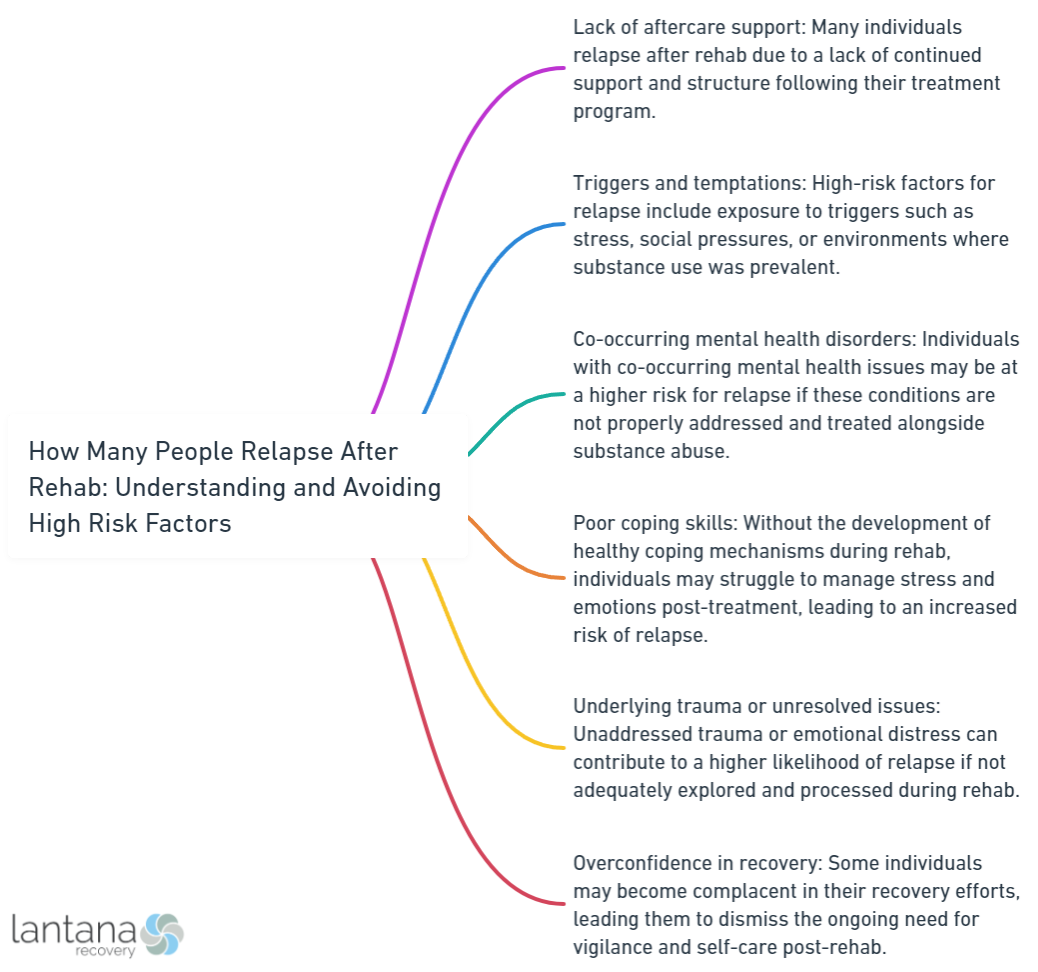Imagine a world where addiction recovery was a linear path, free of setbacks and challenges. Unfortunately, this is not reality; the journey to sobriety is often filled with obstacles, including relapses. But what if we told you that understanding and addressing the risk factors associated with relapse could significantly improve the chances of maintaining long-term sobriety? In this blog post, we will delve into the complexities of relapse, its warning signs, and strategies to prevent it, ultimately providing you with the knowledge and tools necessary to navigate the winding road to recovery, including answering the question: how many people relapse after rehab?
Key Takeaways
- Relapse rates of substance use disorders vary, with alcohol having a higher rate than opioids.
- Factors influencing relapse include stress level, personality traits and type/duration of addiction.
- Strategies for preventing relapse involve recognizing warning signs, developing coping skills & support networks, utilizing behavioral therapies and adjusting treatment plans as needed.
Relapse Rates Following Rehab
Relapse, also known as addiction relapse, is a common occurrence in the addiction recovery process. In fact, relapse occurs in between 40% and 60% of addicts, and over 85% of people return to their previous habits of drug or alcohol use within one year of treatment. Although these numbers might seem daunting, it’s crucial to remember that addiction, like other chronic diseases such as high blood pressure or diabetes, also presents similar relapse rates. Such a perspective underscores the necessity for continuous management and support throughout the recovery process.
Comparing relapse rates among different substance use disorders reveals variations that can influence the recovery journey. For instance, alcohol use disorder has a notably higher relapse rate than opioid use disorder. This information is vital as it helps tailor addiction treatment programs to address the unique challenges posed by specific substance use disorders.

Factors Influencing Relapse Rates
What is relapse and what influences it? Well, relapse is complicated and several factors can contribute to the likelihood of relapse following rehab. These factors include:
- Stress level
- Temperament
- Personality
- Cognitive factors
- Mental distress
- Motivation to change drug abuse behavior
In addition, the type of drug addiction, duration of addiction, and treatment approach can also impact the probability of relapse.
Understanding these factors can aid in adopting suitable strategies for relapse prevention, such as recognizing potential warning signs, understanding common triggers, and adopting lifestyle habits that can help manage triggers and reduce stress. Addressing the distinct challenges presented by each substance use disorder and its associated risk factors is vital.
Comparing Substance Use Disorders
Substance use disorders (SUDs) can differ in terms of:
- The particular substance being used
- The intensity of the disorder
- Substance abuse as a form of substance use
- Diagnostic criteria
- Withdrawal symptoms
- Health risks
- Treatment approaches
As mentioned earlier, relapse rates among different types of SUDs can vary significantly. By understanding these disparities, treatment programs can be tailored to address the unique challenges posed by specific substance use disorders, ultimately improving the chances of successful recovery.
The Chronic Nature of Addiction

Addiction, including alcohol addiction, is a neurological disorder characterized by an individual’s compulsive use of substances. Viewing addiction as a chronic disease, like other chronic medical illnesses, emphasizes the importance of long-term treatment plans and support for managing the condition. Similar to how a person with high blood pressure requires consistent medical supervision and lifestyle adaptations, those in addiction, like if your boyfriend has relapsed, his recovery also need comparable long-term support and commitment to sustain sobriety.
Fulfilling a treatment plan is an accomplishment that can be reflected upon with satisfaction and can contribute to sustained abstinence. In the lifelong journey of recovery, concentrating on remaining abstinent one day at a time is more critical than concerning oneself with long-term statistics. Remember, support is available in various forms, such as support groups, group therapy, a 12-step program, or counseling from experts at Lantana Recovery, to help individuals manage their recovery.
Treatment Approaches for Chronic Diseases
Chronic diseases like addiction necessitate long-term treatment plans and support for effective management. Detoxification can clear the body of drugs and alcohol, but without continued drug addiction treatment, people often go back to using them. Subsequent treatment is necessary in order to break out of an addiction cycle. Therefore, it is essential to incorporate evidence-based treatment approaches, such as cognitive-behavioral therapy, motivational interviewing, and 12-step programs, which have been shown to be effective in reducing relapse rates by providing support and guidance to individuals in addiction recovery.
Long-term recovery necessitates altering deeply ingrained behaviors to avert relapse. Addressing the root causes of addiction involves understanding each patient’s drug use patterns and drug-related medical, mental, and social issues. By doing so, tailored treatment strategies can be developed, ensuring individuals receive the necessary tools and resources to effectively manage triggers, cravings, and stressors, ultimately increasing their chances of sustained recovery.
Recognizing Warning Signs of Relapse

To prevent a full-scale relapse, it’s imperative to identify its warning signs. The three stages of relapse are emotional, mental, and physical. The warning signs may include increased stress, anxiety, depression, negative thought patterns, cravings, changes in sleep patterns, appetite, or appearance. By identifying these warning signs early, individuals can intervene and seek support, minimizing the risk of a full-blown relapse. Stress stemming from employment, financial, and interpersonal issues can cause heightened anxiety, potentially resulting in relapse. Hence, mitigating life stressors and cultivating healthy coping strategies are key to avoiding relapse.
Emotional Warning Signs
Emotional relapse may manifest through signs such as self-care neglect, feelings of despondency, and agitation. Emotional warning signs may manifest as increased irritability, mood swings, anxiety, depression, isolation, and diminished interest in activities previously enjoyed. Identifying these signs is integral to gauging one’s emotional state and garnering the required support to avoid a full-scale relapse.
Common triggers for emotional relapse can include uncontrolled stress, difficulty managing emotions and impulses, and not addressing emotional relapse. By identifying these triggers and seeking support, individuals can learn to better manage their emotions and prevent relapse from occurring.
Mental Warning Signs
Mental relapse is when an individual is faced with conflicting desires to use alcohol or drugs again and to remain abstinent. Signs of mental relapse may include increased thoughts about using substances and conflicting desires to use alcohol or drugs again and remain sober.
Negative thought patterns, cravings, or romanticizing past drug use may be indicative of a potential relapse. By recognizing these mental warning signs, individuals can seek support and develop strategies to manage their thoughts and cravings effectively, thus preventing a full-blown relapse.
Physical Warning Signs
Physical warning signs of relapse may include:
- Withdrawal symptoms such as anxiety, nausea, and physical weakness
- Post-acute withdrawal symptoms
- Changes in appetite or sleep patterns
- Physical cravings for the substance
- Increased tolerance to the substance
- Physical symptoms of stress or tension
Post-acute withdrawal symptoms include:
- Fatigue
- Insomnia
- Anxiety
- Depression
- Cravings for the substance
Recognizing these physical warning signs and seeking support can help individuals address and manage these symptoms, preventing a full-blown relapse.
Strategies for Relapse Prevention

Relapse prevention is a critical element of recovering from substance use disorders, as it assists individuals in recognizing and handling potential triggers and constructing techniques to remain abstinent. There are various strategies available for relapse prevention, such as:
- Developing coping skills
- Building a support network
- Identifying and avoiding triggers
- Practicing self-care
- Setting realistic goals
- Continuing therapy or counseling
- Developing a relapse prevention plan
Investigating underlying issues such as:
- codependency
- enabling behavior
- family dynamics
- control issues
- acceptance
Can assist individuals in sustaining sobriety. In the following sections, we will explore effective relapse prevention strategies in more detail.
Behavioral Therapies
Behavioral therapies, such as cognitive-behavioral therapy (CBT), play a crucial role in preventing relapse by addressing deeply rooted behaviors and thought patterns. CBT emphasizes:
- Modifying behaviors and thought processes to address the root causes of addiction
- Assisting individuals in recognizing and responding to relapse triggers
- Cultivating strategies to manage high-risk scenarios
- Reducing the chances of relapse
“Cognitive behavioral therapy (CBT) for substance use disorders has demonstrated efficacy as both a monotherapy and as part of combination treatment strategies” (CBT for SUDs, McHugh et al., 2011.) By focusing on altering deeply ingrained behaviors and thought patterns, individuals can effectively manage their triggers and cravings, ultimately reducing the risk of relapse and achieving long-term sobriety.
Support Groups and Accountability
Support groups and accountability measures, such as having a sponsor or mentor, can be invaluable resources for individuals striving to maintain sobriety and prevent relapse. These groups provide:
- Emotional support
- Specialized treatment
- Guidance
- Responsibility and motivation
When seeking assistance when dealing with relapse, it is essential to:
- Be candid and transparent about the situation
- Be tolerant and compassionate, as it may take time to find the appropriate support
- Be proactive in taking action to avert a relapse from intensifying
The support of friends, family, and professionals can make a significant difference in one’s recovery journey.
Coping Mechanisms and Lifestyle Changes
Developing healthy coping mechanisms and making lifestyle changes can assist individuals in managing their triggers and cravings more effectively, thus reducing the risk of relapse. Examples of coping mechanisms and lifestyle changes that can help minimize the risk of relapse include:
- Avoiding potentially hazardous situations
- Cultivating healthy coping skills
- Engaging in physical activity
- Ensuring adequate rest
Individuals can take measures such as setting realistic goals, creating a plan of action, and seeking help and support from family, friends, and professionals to implement coping mechanisms and lifestyle changes. By taking these steps, individuals can reduce their risk of relapse and achieve lasting sobriety.
Handling Relapse: Steps to Take

Relapse is not the end of the road in the recovery journey. It is merely a bump on the path to long-term sobriety. In the event of a relapse, it is advisable to:
- Seek assistance from professionals at an institution like Lantana promptly
- Reaffirm commitment to long-term abstinence
- Secure a sponsor or an accountability partner to aid in regaining momentum in the recovery process.
Assessing triggers and stressors is critical to comprehend the situations, people, and places that can lead to relapse, and to devise strategies to evade them. Creating a relapse prevention plan that recognizes potential triggers and stressors, devises coping strategies, and assembles a support system can significantly help in preventing future relapses.
Reaching Out for Help
Seeking assistance when managing relapse is essential as it offers:
- Support
- Accountability
- Insight
- Resources
- Help in avoiding a relapse from intensifying
Support is available in various forms, such as friends, family, or a sponsor, and professional assistance, including therapy, support groups, and addiction counselors.
The benefits of seeking help during relapse include:
- Emotional backing
- Specialized therapies
- Guidance
- Fostering responsibility
- Motivation
By seeking help and support, individuals can cultivate more beneficial coping strategies for emotional relapse and lifestyle modifications, ultimately preventing relapse and maintaining long-term sobriety.
Adjusting Treatment Plans
In the aftermath of a relapse, it’s important to reassess and adjust treatment plans to cater to the specific needs and hurdles that emerge. It is beneficial to identify and address the factors that contributed to the relapse, modify treatment strategies, and provide additional support to prevent further setbacks. By adjusting the treatment plan, individuals can receive the necessary tools, therapies, and resources to effectively manage triggers, cravings, and stressors, increasing their chances of sustained recovery.
Learning from the Experience

Learning from a relapse experience is crucial as it strengthens sobriety, aids in identifying triggers and warning signs, promotes personal growth and introspection, enables corrective measures, and diminishes the chances of future relapses. Recognizing patterns of behavior, thoughts, and emotions that lead to relapse can be used to identify triggers and warning signs, thus taking steps to prevent relapse.
Relapse can be utilized as a chance for personal growth and self-awareness by reflecting on the experience and recognizing what prompted the relapse. This can help to recognize areas of enhancement and create tactics to avert future relapses.
Success Stories: Overcoming Relapse

Inspiring stories of individuals who have overcome relapse and achieved long-term sobriety remind us that successful recovery is possible even after setbacks. These accounts offer an understanding of the difficulties of recovery and the approaches that have been effective in conquering relapse. For instance, Drake et al., state that studies show that individuals with co-occurring disorders are at a significant risk of relapsing into substance abuse, even after achieving complete remission but that doesn’t mean that recovery is impossible.
With adequate support, resources, and strategies, individuals can overcome relapse and attain long-term sobriety. Remember, the journey to recovery is a lifelong commitment, and setbacks are merely opportunities for growth and improvement.
Summary
In conclusion, relapse is a common occurrence in the addiction recovery process. However, understanding the factors influencing relapse rates, recognizing warning signs, and implementing effective relapse prevention strategies can significantly improve the chances of maintaining long-term sobriety. The journey to sobriety is a lifelong commitment, and setbacks are merely opportunities for growth and improvement. By staying proactive, seeking support, and remaining dedicated to recovery, individuals can overcome relapse and achieve lasting sobriety.
Remember, the road to recovery is not a straight line, but with determination, support from experts at Lantana, and the right tools, you can navigate the winding path to a sober and fulfilling life.
Frequently Asked Questions
What is the probability of relapse?
Unfortunately, the probability of relapse after entering recovery from a drug or alcohol addiction is fairly high, ranging from 40-60% within 30 days to 85% within one year.
What substance has the highest rate of relapse?
Heroin (an opioid drug) has the highest rate of relapse of any substance, with statistics for heroin addiction relapse as high as 90%. This is due to the intense physical and psychological cravings that come with opioid addiction. The cravings can be so strong that even after a period of abstinence, the user may find themselves unable to resist the urge to use again.
What is the percentage of relapse in AA?
Regrettably, studies show that 40-60% of individuals participating in Alcoholics Anonymous (AA) relapse within 30 days of leaving an inpatient program, with up to 85% relapsing within a year. This is a concerning statistic, and it highlights the need for more effective treatments for alcohol addiction.
What percentage of addicts get sober?
Around 75% of those who seek addiction treatment achieve sobriety.
What is the most common time of relapse?
Relapse within 30 days of leaving an inpatient drug and alcohol treatment center is the most common time of relapse, with rates as high as 85% within the first year. This is why it is so important to have a strong aftercare plan in place before leaving treatment. This plan should include ongoing therapy, support groups, and other resources to help maintain sobriety. Additionally, having a strong support system of family and friends can be beneficial.









